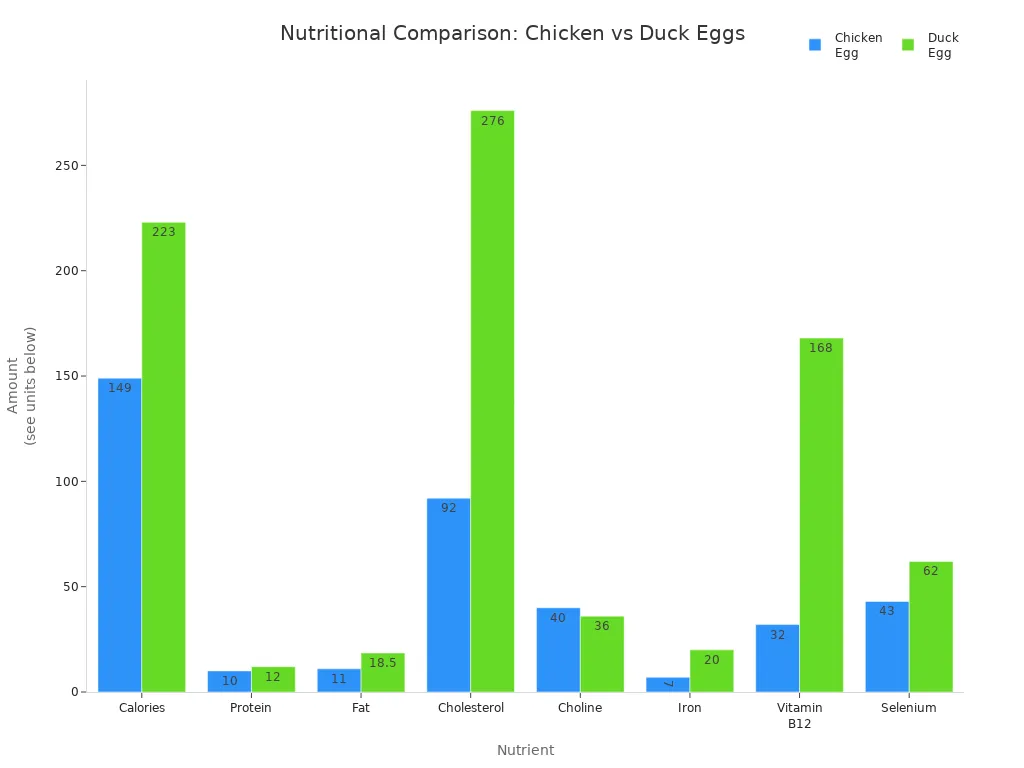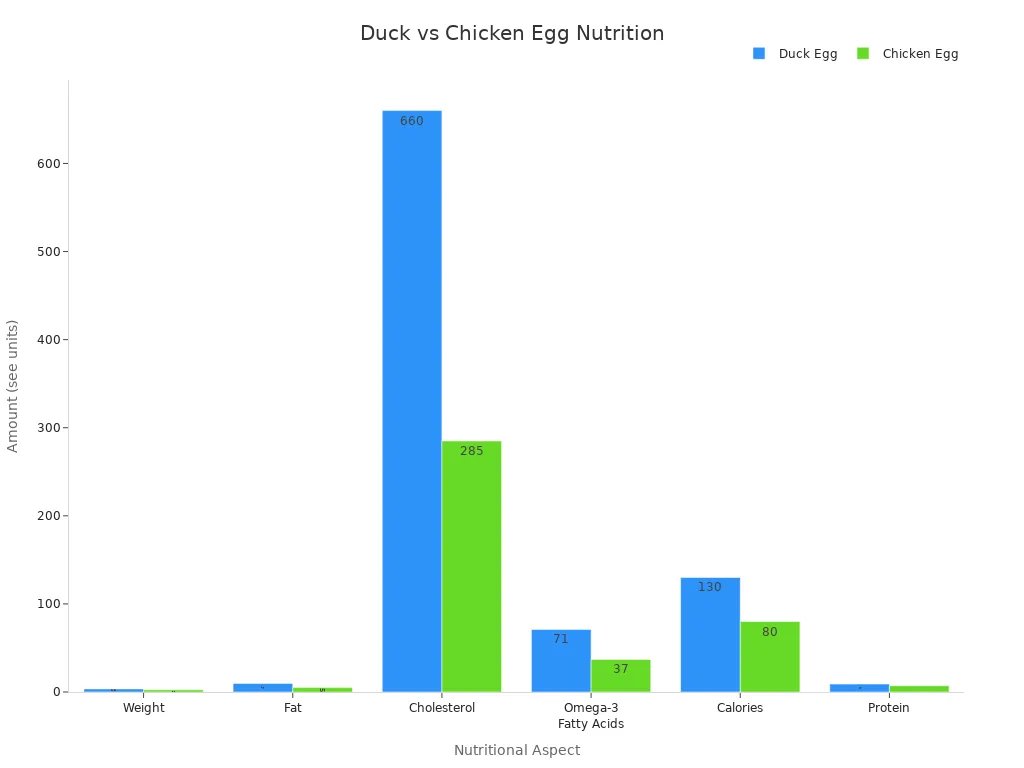
You might see many types of eggs in stores or markets worldwide. Each type comes from a different bird or fish and offers unique benefits. People everywhere eat more eggs because they give important nutrients and fit many diets.
In the EU, egg consumption keeps rising every year.
Eggs help support healthy food systems and meet different budgets.
Egg Type | Nutritional Highlights |
|---|---|
Chicken | Packed with nutrients, easy to find and cook |
Duck | Larger, more protein, rich in antioxidants |
Quail | Tiny, high in B12 and selenium |
Goose | Full of vitamins A, D, E, and B vitamins |
Curiosity leads you to discover new flavors and nutrition by exploring the types of eggs found around the world.
Key Takeaways
Explore different types of eggs like chicken, duck, quail, and goose to enjoy unique flavors and nutritional benefits.
Choose eggs based on labels like ‘organic’ or ‘free-range’ for better nutrition and animal welfare.
Incorporate eggs into your meals for high-quality protein and essential nutrients that support overall health.
Try global dishes featuring eggs, such as shakshuka or tamagoyaki, to expand your culinary experience.
Understand the cultural significance of eggs in celebrations and traditions to appreciate their role in various cuisines.
Types of Eggs Worldwide

You can find many types of eggs in kitchens and markets across the globe. Each type comes from a unique animal and brings its own nutritional and culinary benefits. Let’s explore what makes each of these different types of eggs special and where you might find them.
Chicken Eggs
Chicken eggs are the most popular type of egg worldwide. You see them in almost every grocery store and restaurant. People have valued eggs from chickens since ancient times. Chickens were first domesticated for their eggs in Southeast Asia before 7500 BCE. By 1500 BCE, chicken eggs had reached Sumer and Egypt. By 800 BCE, they appeared in Greece, replacing quail eggs as the main egg source. Columbus brought chickens to the Americas in the 1490s. Today, the United States produces about 75 billion chicken eggs each year.
Chicken eggs are easy to cook and fit many recipes. You can scramble, fry, boil, or bake them. They are a staple in breakfast dishes, baked goods, and sauces.
Here is a table comparing chicken eggs with other popular types of eggs:
Nutrient | Chicken Egg | Duck Egg |
|---|---|---|
Calories | 149 | 223 |
Protein | 10 grams | 12 grams |
Fat | 11 grams | 18.5 grams |
Cholesterol | 92% DV | 276% DV |
Choline | 40% DV | 36% DV |
Iron | 7% DV | 20% DV |
Vitamin B12 | 32% DV | 168% DV |
Selenium | 43% DV | 62% DV |

You can choose from different types of hen eggs, such as conventional, cage-free eggs, free-range eggs, organic eggs, pasture raised eggs, and omega-3 enriched eggs. Asia Pacific, especially China and India, holds the largest market share for eggs.
Duck Eggs
Duck eggs are larger than chicken eggs and have a richer taste. You find duck eggs in French and Asian cuisines. In France, people enjoy them poached or fried with asparagus, ham, potatoes, or salmon. Asian dishes often use preserved duck eggs, like the century egg in China.
Duck eggs contain more protein, fat, and omega-3 fatty acids than chicken eggs. They also have higher levels of vitamin B12 and selenium. Here is a table showing how duck eggs compare to chicken eggs:
Nutritional Aspect | Duck Egg | Chicken Egg |
|---|---|---|
Weight | 3.5 ounces | 2.5 ounces |
Fat | 9.6 grams | 5 grams |
Cholesterol | 660 mg | 285 mg |
Omega-3 Fatty Acids | 71 mg | 37 mg |
Calories | 130 | 80 |
Protein | 9 grams | 7 grams |

Duck eggs add richness to dishes like gougeres, carbonara, and creme brulee. You can use them in fresh pasta, ice cream, and custard. Duck eggs work well in breakfast dishes such as scrambled eggs and French toast. They pair nicely with meats like ham or duck breast.
Quail Eggs
Quail eggs are tiny but packed with nutrients. You often see them in urban areas with health-conscious consumers. Regions with growing awareness of nutrition also use quail eggs more often. These eggs contain protein, iron, selenium, vitamin A, vitamin B12, and vitamin D.
Nutrient | Amount |
|---|---|
Protein | 1.17 g |
Total fats | 1 g |
Cholesterol | 76 mg |
Calcium | 5.76 mg |
Magnesium | 1.17 mg |
Phosphorous | 20.3 mg |
Potassium | 11.9 mg |
Sodium | 12.7 mg |
Iron | 0.37 mg |
Selenium | 2.88 µg |
Zinc | 0.13 mg |
Vitamin A | 48.9 IU |
Vitamin B1 | 0.01 mg |
Vitamin B2 | 0.07 mg |
Vitamin B6 | 0.01 mg |
Vitamin B12 | 0.14 µg |
Vitamin E | 0.1 mg |
Vitamin D | 4.95 IU |
Vitamin K | 0.03 µg |
You find quail eggs in many traditional dishes. In Brazil, hard-boiled quail eggs are a popular appetizer called ovo de codorna com molho rose. In the Philippines, kwek kwek is a street food featuring deep-fried quail eggs. In Thailand, you can try a quail egg omelette. Asian cuisine often includes quail eggs in soups, such as bird’s nest soup.
Goose Eggs
Goose eggs are much larger than chicken eggs and have a strong flavor. You see goose eggs in European and Asian recipes. They are rich in protein, vitamin A, iron, selenium, and choline.
Nutrient | Goose Egg | Chicken Egg |
|---|---|---|
Calories | 266 | 72 |
Protein (g) | 19.97 | 6.23 |
Vitamin A (% RDA) | 19% | N/A |
Iron (% RDA) | 29% | N/A |
Selenium (mg) | 53.1 | N/A |
Choline (mg) | 379 | N/A |
Cholesterol (mg) | 1,227 | 186 |
Monounsaturated Fats | Higher | N/A |
Saturated Fats | Higher | N/A |
Goose eggs work well in savory tarts, main courses, soups, and sandwiches. You can use them as a base for tarts with asparagus and pesto. Fried goose eggs pair with venison steak or pasta dishes like carbonara. Asian recipes include goose egg congee, a rice porridge. Goose eggs also enhance egg salad sandwiches, such as the German Eiersalat.
Ostrich Eggs
Ostrich eggs are the largest eggs you can buy. They measure about 6 inches long and weigh around 5 pounds. One ostrich egg contains about 2,000 calories, 100 grams of fat, and 235 grams of protein. Ostrich eggs have less vitamin E but more magnesium and iron than chicken eggs. They contain no sodium.
Ostrich eggs are versatile in cooking. You can scramble, boil, or bake them. Their large size makes them perfect for gatherings. Ostrich eggs have a buttery taste and work well in omelettes and baked goods. Their thick shells require special tools to crack open, which makes preparation unique.
Fish Eggs (Caviar and Roe)
Fish eggs, known as caviar and roe, come from many fish species. You find sturgeon roes like Beluga, Osetra, Sevruga, and Sterlet. Non-sturgeon roes include paddlefish roe, salmon roe (ikura), trout roe, masago (capelin roe), and tobiko roe. People enjoy fish eggs in Russia, Japan, and Europe. Caviar is a luxury food, often served as a garnish or appetizer. Salmon roe is popular in Japanese sushi.
Fish eggs are high in protein, omega-3 fatty acids, and vitamins. They add flavor and texture to many dishes.
You can explore different egg varieties from birds and fish to discover new tastes and nutritional benefits. Trying different types of eggs helps you learn about global cuisines and traditions.
Benefits of Eggs

Nutrition
Eggs are one of the most nutrient-rich foods you can eat. They provide high-quality protein, which your body uses to build and repair tissues. Each egg contains about 6 grams of protein and all nine essential amino acids. You also get choline, which supports brain health and helps your nerves work well. Eggs contain antioxidants like lutein and zeaxanthin that protect your eyes from disease.
Nutrient | Amount per Egg | Daily Value (%) |
|---|---|---|
Protein | 6 grams | – |
Choline | 147 mg | 27% |
Antioxidants | Lutein, Zeaxanthin | – |
Egg yolks are rich in proteins, healthy fats, and vitamins A, D, E, and K. Egg whites have no fat but offer plenty of proteins. You also get minerals like selenium and iodine, which support your immune system and thyroid. Eating eggs gives you a nutrient-rich food that supports your health in many ways.
Eggs provide all nine essential amino acids, making them a complete source of proteins.
Culinary Uses
You find edible eggs in many dishes around the world. Chefs use eggs to clarify broths, enrich baked goods, and create sauces like mayonnaise. Eggs help bind ingredients in burgers and meatballs. You can use eggs to glaze pastries or thicken soups and custards. When you beat eggs, they add air to cakes and soufflés, making them light and fluffy.
Some famous dishes show how versatile eggs are:
Shakshuka: You poach eggs in a spicy tomato sauce, which gives a comforting texture.
Tamagoyaki: This Japanese rolled omelet uses layers of eggs for a smooth, delicate taste.
Egg Bhurji: In India, you scramble eggs with spices for a flavorful meal.
Edible eggs are a key part of nutrient-rich foods in every cuisine. You can try new recipes and enjoy the many benefits of eggs in your meals.
Cultural Significance
Eggs play a big role in many cultures. People use eggs in festivals and traditions to symbolize new life, fertility, and renewal. During Easter, you might join an egg hunt or decorate eggs. In China, families celebrate newborns with red eggs. Painted eggs appear on the Haft-Seen table in Iran for Nowruz, marking the start of spring. In Mexico, eggs are part of Day of the Dead dishes to honor ancestors.
Many cultures have fun games with eggs, such as egg rolling in Scotland or egg tapping in Greece. In Jewish tradition, eggs represent hope and comfort during special meals. Archaeologists have found ostrich eggs in ancient tombs, showing that people valued eggs for thousands of years.
You see that edible eggs are more than just food. They connect people through shared traditions and celebrations, showing the many health benefits and cultural meanings of eggs.
Egg Classification
Free-Range, Cage-Free, Organic
You see many types of eggs in stores, each with its own label. These labels tell you how the hens live and what they eat. Here is a table that explains the main global classifications:
Type of Egg | Description |
|---|---|
Conventional Eggs | Hens live in cages with unlimited feed and water. This system is efficient but limits movement. |
Cage-Free Eggs | Hens can roam inside a building. They do not go outside but can move around more than caged hens. |
Organic Eggs | Hens are cage-free, have outdoor access, and eat organic feed. They live in more natural conditions. |
Free-Range Eggs | Hens have outdoor access and more space. This promotes better welfare than cage-free systems. |
Pasture-Raised Eggs | Hens spend a lot of time outdoors. This label is not always regulated but often means more space. |
Eggs from organic and free-range hens often have higher omega-3 and vitamin D levels. Hens that go outside get more sunlight and eat a varied diet, which can improve the nutrition of their eggs.
Egg Grades and Sizes
Eggs come in different grades and sizes. Grading tells you about the egg’s quality and freshness. Here is what each grade means:
Grade | Criteria |
|---|---|
AA | Clean, unbroken shell; small air cell; firm white; yolk slightly defined. |
A | Clean, unbroken shell; slightly larger air cell; reasonably firm white; yolk well defined. |
B | Unbroken shell (may look odd); large air cell; watery white; yolk outline is dark. |
Grade AA and A eggs are best for eating as they are.
Grade B eggs usually go into processed foods.
Eggs also come in sizes like medium, large, and extra-large. Most recipes use large eggs. Size can change the nutrition a little, but all eggs give you protein and vitamins. For baking, using the right size helps your recipe turn out well.
Labels and What They Mean
Egg labels help you know what you are buying. Here is what common labels mean:
Cage-free: Hens roam indoors but do not go outside.
Free-range: Hens have some outdoor access, but the time outside can vary.
Pasture-raised: Hens spend a lot of time outdoors, often with more space.
Organic: Hens eat organic feed and live under strict rules for health and welfare.
Tip: Labels can affect nutrition and quality. For example, organic and pasture-raised eggs may have more omega-3 and vitamin D.
In some countries, people pay more for eggs with labels like “organic” or “omega-3”. You might see different choices in stores based on what people value most, such as health or animal welfare.
Eggs from around the world offer you a wide range of flavors, nutrients, and traditions.
You find eggs that boost growth and development, like those rich in protein, vitamin B12, and vitamin D.
High-quality eggs, such as pasture-raised, give you more omega-3s and better taste.
Unique varieties, including tea eggs, duck eggs for baking, and quail eggs in street food, add excitement to your meals.
Exploring new types of eggs lets you enjoy global dishes and discover what makes each egg special. Try something new and celebrate the richness eggs bring to your table! 🥚🌍
FAQ
What makes duck eggs different from chicken eggs?
Duck eggs have more protein, fat, and vitamins than chicken eggs. You notice a richer taste and larger size. Many bakers use duck eggs for fluffier cakes and pastries.
What are the health benefits of eating quail eggs?
Quail eggs give you protein, vitamin B12, and selenium. You get a nutrient boost in a small package. Many people enjoy them as snacks or in salads.
What is caviar, and how do you eat it?
Caviar is salt-cured fish eggs, usually from sturgeon. You eat caviar on crackers, toast, or with eggs. It adds a salty, rich flavor to dishes.
What do egg labels like “organic” or “free-range” mean?
Egg labels tell you how hens live and what they eat. “Organic” means hens eat organic feed and go outside. “Free-range” means hens have outdoor access. These labels help you choose eggs that fit your values.
What is the largest edible egg in the world?
The ostrich egg is the largest edible egg. One ostrich egg can weigh up to 5 pounds. You can use it to make a big omelet or scramble for a group.


